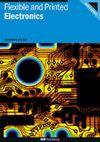A fully printed sensor with optical readout for real-time flow monitoring
IF 3.2
4区 工程技术
Q3 MATERIALS SCIENCE, MULTIDISCIPLINARY
引用次数: 0
Abstract
In recent years, there has been a growing interest in the development of flexible thermal flow sensing devices due to their wide-ranging applications. In this study, we present the fabrication of a screen-printed optical flow sensor on a 125 μm PET substrate in a three-layer configuration. The device comprises electrodes made from a commercial Ag ink, a heating area using a commercial carbon ink, and a thermochromic layer employing a commercial ink with a standard activation temperature of 31°C. We designed a specialized experimental setup to evaluate the performance of the optical flow sensor under static and dynamic conditions. To analyze the device's thermal response and performance across various flow conditions, we utilized a combination of electrical measurements and IR-optical imaging techniques. The all-printed device operates on the basis of a thermodynamic cycle frequency, which activates the thermochromic ink, causing it to blink at a frequency related to the flow passing over the sensor. The results of our preliminary testing are highly promising, as the sensor successfully demonstrated a clear relationship between flow and optical duty cycle. This innovative device offers a contactless, low-cost, easy-to-use flow detection method and holds significant potential for various practical applications.带光学读数的全印刷传感器,用于实时流量监测
近年来,由于柔性热流传感设备的广泛应用,人们对其开发的兴趣与日俱增。在本研究中,我们在 125 μm PET 基底上以三层结构制作了丝网印刷光流量传感器。该装置包括由商用银墨制成的电极、使用商用碳墨的加热区以及使用标准激活温度为 31°C 的商用墨水的热致变色层。我们设计了一个专门的实验装置来评估光学流量传感器在静态和动态条件下的性能。为了分析该装置在各种流动条件下的热响应和性能,我们结合使用了电学测量和红外光学成像技术。全印刷设备的工作基于热力学循环频率,该频率会激活热致变色油墨,使其按照与流过传感器的流量相关的频率闪烁。我们的初步测试结果很有希望,因为传感器成功证明了流量与光学占空比之间的明确关系。这种创新装置提供了一种非接触、低成本、易使用的流量检测方法,在各种实际应用中具有巨大潜力。
本文章由计算机程序翻译,如有差异,请以英文原文为准。
求助全文
约1分钟内获得全文
求助全文
来源期刊

Flexible and Printed Electronics
MATERIALS SCIENCE, MULTIDISCIPLINARY-
CiteScore
4.80
自引率
9.70%
发文量
101
期刊介绍:
Flexible and Printed Electronics is a multidisciplinary journal publishing cutting edge research articles on electronics that can be either flexible, plastic, stretchable, conformable or printed. Research related to electronic materials, manufacturing techniques, components or systems which meets any one (or more) of the above criteria is suitable for publication in the journal. Subjects included in the journal range from flexible materials and printing techniques, design or modelling of electrical systems and components, advanced fabrication methods and bioelectronics, to the properties of devices and end user applications.
 求助内容:
求助内容: 应助结果提醒方式:
应助结果提醒方式:


